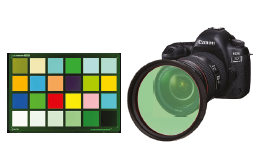
A database of realizable filters is created and searched to obtain the best filter that, when placed in front of an existing camera, results in improved colorimetric capabilities for the system. The image data with the external filter is combined with image data without the filter to provide a six-band system. The colorimetric accuracy of the system is quantified using simulations that include a realistic signal-dependent noise model. Using a training data set, we selected the optimal filter based on four criteria: Vora Value, Figure of Merit, training average ΔE, and training maximum ΔE. Each selected filter was used on testing data. The filters chosen using the training ΔE criteria consistently outperformed the theoretical criteria.

The H.265/HEVC (High Efficiency Video Coding) codec and its 3D extensions have crucial rate-distortion mechanisms that help determine coding efficiency. We have introduced in this work a new system of Lagrangian parameterization in RDO cost functions, based on semantic cues in an image, starting with the current HEVC formulation of the Lagrangian hyper-parameter heuristics. Two semantic scenery flag algorithms are presented and tested within the Lagrangian formulation as weighted factors. The investigation of whether the semantic gap between the coder and the image content is holding back the block-coding mechanisms as a whole from achieving greater efficiency has yielded a positive answer.